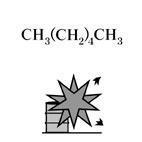| Case Name |
Explosion at a rotating filter caused due to high oxygen concentration generated from operation with defective monitoring instrument |
| Pictograph |

|
| Date |
July 1, 1989 |
| Place |
Izumisano, Osaka, Japan |
| Location |
Food factory |
| Overview |
On July 1st, 1989, a horizontal filter exploded at a cooking oil manufacturer during a filtering operation to separate crystals produced by mixing animal fat and hexane. The side cover and the upper part of the horizontal filter broke over 1/4 of the circumference. The wall and ceiling of the horizontal filter chamber were damaged. At the time of the accident, the oxygen concentration in the horizontal filter chamber was more than 11.9%, the explosion lower limit of combustible vapor containing n-hexane. This explosion was considered to have been ignited by a spark resulting from accumulated static electricity at the flange of piping. |
| Incident |
A filtration unit exploded at a cooking oil manufacturer. A rotary filter to separate flammable oil and solids was operated with an oxygen meter that was defective, resulting in an explosion. Refer to Fig2. |
| Processing |
Manufacture |
| Individual Process |
Separation |
| Process Flow |
Fig3.Unit process flow
|
| Substance |
Hexane, Fig4 |
| Type of Accident |
Explosion |
| Sequence |
A horizontal filter exploded on separating liquids and solids produced by agitating animal fat and hexane with cooling. The side cover and the upper part of the horizontal filter broke over 1/4 of the circumference. The wall and ceiling of the horizontal filter chamber were damaged. Workers at the site extinguished the fire and all of the operations of the plant were subject to an emergency shutdown by an automatic fire alarming system. |
| Cause |
The oxygen concentration in the horizontal filter chamber is kept at 8-10%. Nitrogen supply control did not work due to a failure of an oxygen monitor, and oxygen concentration at the time of the accident exceeded 11.9% (the lower explosion limit of n-hexane containing combustible vapor). Bonding defects at the flange of the piping were found during inspection after the accident, and the fire was considered to have been started by a spark due to accumulated static electricity. |
| Response |
Fire extinguishing with a foam fire extinguisher. An emergency shut-down of the plant |
| Countermeasures |
Automation and inspection of a nitrogen gas purging system |
| Knowledge Comment |
Never operate facilities when measurement to secure safety is not possible, otherwise a serious accident is likely to result. |
| Background |
Operation with the coexistence of air and hydrocarbons is generally quite dangerous. Such an operation should never be done without a working oxygen monitor. It was serious negligence in operation management.
Ignorance of bonding defects was another serious problem in facilities management. Ignorance of static electricity or negligence is also suspected. |
| Reason for Adding to DB |
Example of explosion caused under operation conditions where the most important instrument could not be used |
| Scenario |
| Primary Scenario
|
Poor Value Perception, Poor Safety Awareness, Inadequate Risk Recognition, Ignorance, Insufficient Knowledge, Convincement, Malicious Act, Rule Violation, Safety Rule Violation, Usage, Maintenance/Repair, Not repaired, Malfunction, Poor System, Bad condition of Safety System, Bad Event, Electrical Failure, Breaking of Wire, Secondary Damage, External Damage, Explosion, Loss to Organization, Economic Loss
|
|
| Sources |
Fire and Disaster Management Agency. Major cases of accidents. Explosion of a horizontal filter. Accident Cases of dangerous materials. pp.32,62-63.
|
| Physical Damage |
A horizontal filter, a filter housing, etc. were scattered over a radius of 20 m from the factory. Damage to the wall and roof of a filter chamber. 2450 L of N-hexane and 1050 L of vegetable oil and animal oil were lost. |
| Financial Cost |
¥60 million. (Accident cases of dangerous materials) |
| Multimedia Files |
Fig2.Schematic diagram
|
|
Fig4.Chemical formula
|
| Field |
Chemicals and Plants
|
| Author |
YOSHINAGA, Jun (Graduate School of New Frontier Sciences, The University of Tokyo)
TAMURA, Masamitsu (Center for Risk Management and Safety Sciences, Yokohama National University)
|